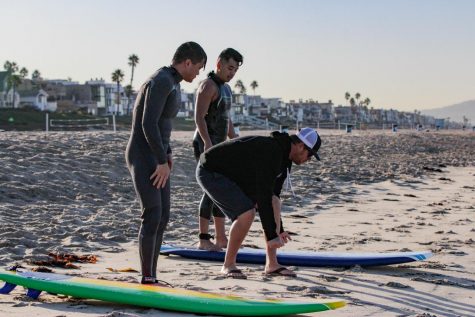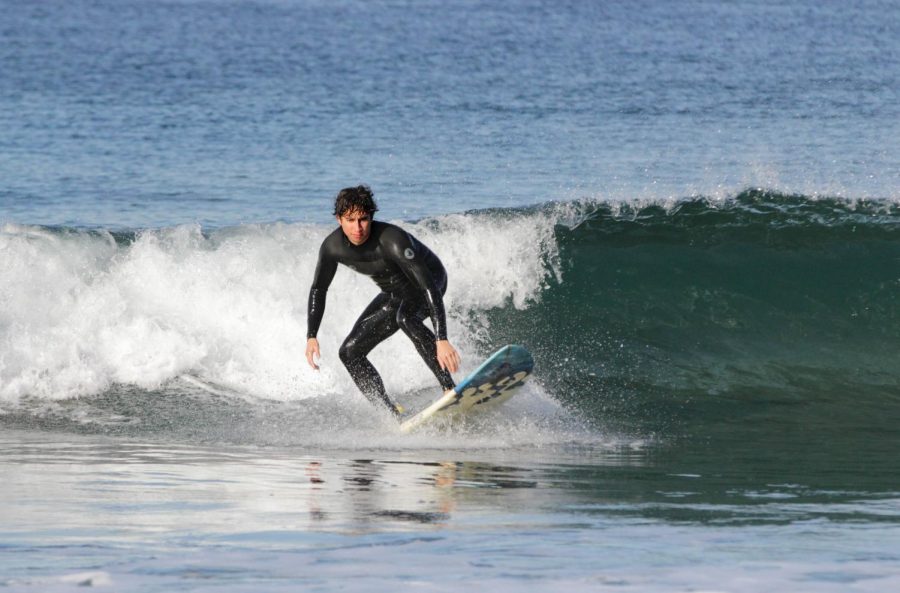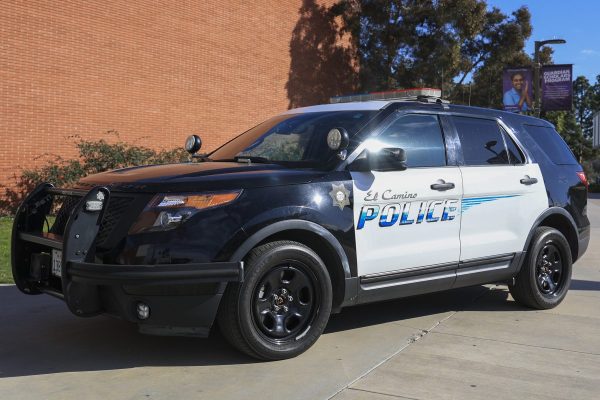A professor’s role in the movement that made surfing California’s official sport
Giancarlo Cotta, 21, fire and emergency technology major, one of surf instructor Kurt Peters’ students, rides in front of a wave at The Strand Friday, Oct.11. Peters’ surfing class is only available during the Fall semester. “There is just something about being in the water, being on your own, you’re out there with your own thoughts whether you’re surfing with friends or by yourself,” Peters said. Rosemary Montalvo/The Union
The half-mile stretch of beach bordered by the El Segundo Chevron oil refinery looms against the northern sky, extending out to the southern pier.
Silhouetted figures of surfers scattered outside the beach break can be observed sitting atop their surfboards since the crack of dawn, idling over the swells of El Porto where the Manhattan Beach air is blanketed by the constant sound of waves crashing and crumbling into a foamy whitewash.
Every Friday morning during the fall semester, Kurt Peters, an adjunct professor and surfing instructor from El Camino College, meets his ECC class for surfing lessons.
While Peters takes attendance in the parking lot, his class slips into their neoprene wetsuits as the locals hanging around having a casual conversation with someone sitting in a van listening to Neil Young’s “Out on the Weekend.”
In no time after that, Peters’s students are out in the water jockeying toward the swells.
The class is in session.
Peters pops up on a right breaking wave and heads south a few yards with little effort, demonstrating to his students how the techniques of prone paddling can facilitate a good take off on a wave if applied effectively.
“There’s just something about being in the water, being on your own, you’re out there with your own thoughts whether you’re surfing with friends or by yourself,” Peters said. “Sometimes you’re humbled by the ocean when you get up and you get out with your tail tucked between your legs and you go home but you try again the next day.”
For the past five years, Peters has been teaching the course Techniques of Surfboard Riding, or Physical Education 250, at ECC. The lessons emphasize the importance of ocean safety, understanding weather conditions, wave selection, the handling of surfboards and safe riding practices.
“It’s hard work,” Peters said observing his students from the shore where the backwash barely reaches his feet.

Rosemary Montalvo/The Union
For the next hour, the students struggle to pop into a standing position as they’re pounded by 4-foot waves that knock them off their surfboards and send them plummeting into the water.
Some grab a hold of their footing just long enough to ride a breaker while others sit patiently studying the water, waiting for the next set as they catch their breath.
ECC students can sign up for the class during the fall semester and experience the sport that has become an emblem of California culture and the state’s official sport after former Governor Jerry Brown signed Assembly Bill 1782 (AB 1782) into law last summer.
“I’m stoked that surfing is now California’s official sport,” the author of AB 1782 Al Muratsuchi, said in a statement following the bill’s passage into law. “No other sport represents the California dream better than surfing, riding the waves of opportunity and living in harmony with nature.”
The law cites the rich cultural history of the sport created and brought to California by the Polynesian people of Hawaii and lists the number of famous surf breaks nestled along the 1,100-mile stretch of coastline.
A number of indigenous people including the Chumash, the Acjachemen (Panhe), the Amah Mutsun, the Ohlone and the Achachemen and Tongva, still live within their ancestral lands and have since embraced surfing as well.
For those who enroll in Peters’ course, a single unit can be earned but 22-year-old Katie Hanks said the experience transcends grades, units or GPA scores.
“There’s something very humbling about being in the water,” Hanks said, gazing toward the horizon after the surf session had ended. “It’s constantly and physically demanding so you’re always in this state of movement where you’re not really thinking about yourself or anyone else, I like that.”
Surfing has the ability to connect one to that jumping-off place in nature that allows for reflection, ECC history professor, Arthur Verge told The Union.
Its participants can learn to “recognize the beauty and the value the ocean has to offer as a source for the many things that help us become healthy and happy human beings,” Verge said.
“It’s one of those things that gets you as close to nature as you can get. It’s unpredictable, it is what Lucero Luca called ‘the ultimate pleasure,'” Verge added. “I hope more people take advantage of [this class].”
Verge, who was a Los Angeles County Lifeguard for 42 years still paddles out into the waves occasionally. As a historian, he authored a comprehensive article titled, “George Freeth: King of the Surfers and California’s Forgotten Hero,” about the Pacific Islander who first introduced surfing to LA.
According to the article, in 1907 a large crowd gathered on the beach a few miles north of El Porto in Venice Beach, enthralled at the sight of a man riding the waves on a wooden board just off the coast. In less than a month after having landed in California from Hawaii, Freeth had made the local headlines in the Santa Monica newspaper, The Daily Outlook17, that read: “Surf Riders Have Drawn Attention.”
“After that, everybody and their grandmothers wanted to be a surfer,” he added.
Thanks to Peters’ ties to CampSurf, a Manhattan Beach-based surf school that provides surfing instruction for people of all ages all year long, students registered in the class can rent a wetsuit and surfboard for $10 per session.
Prior to teaching students how to surf at ECC, Peters was able to hone his skills as an instructor at CampSurf where he not only taught children and adults the art of riding waves but he participated in teaching military veterans how to surf as part of the Wounded Warriors Project, a program that aims to help military veterans overcome the traumas of war.
Peters’s experience as a surfer was solidified after his father taught him how to surf when he was five years old near the same spots at El Porto where he now instructs ECC students.
He understands the challenge those in his class have undertaken as they press forward in their endeavors to ride the waves. It is a sport that will quickly teach students how to have respect for the ocean, as it can be filled with potential dangers such as riptides and strong ocean currents but he is confident that every one of them will come out a better rider as a result.
“I’ve done it all my life so I can see things in the water that others might not,” Peters said. “And I work to keep them out of danger but the ocean doesn’t take any time out, so that’s one of the things that people will learn real fast when they’re out there but it’s pretty rewarding, it’s a lot of work but it’s fun.”











